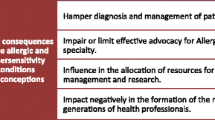Abstract
We present a user-friendly visual representation of The National Institute of Allergy and Infectious Disease and the Food Allergy and Anaphylaxis Network criteria so as to enhance recognition of anaphylaxis and active teaching and learning.
Similar content being viewed by others
Anaphylaxis is a potentially fatal acute systemic allergic reaction. It is becoming increasingly common. [1, 2] Multiple studies have shown that anaphylaxis is both under-recognized and under-treated. [3–5]
Anaphylaxis is known to have varied presentations involving different organ systems. There are no universally accepted criteria for diagnosis of anaphylaxis. Lack of standardized diagnostic criteria has hampered diagnosis and management of anaphylaxis. The National Institute of Allergy and Infectious Disease and the Food Allergy and Anaphylaxis Network (NIAID/FAAN) organized an international symposium in 2005 at which new diagnostic criteria for anaphylaxis were proposed. Although not prospectively validated, these criteria provide physicians with a rapid and simplified means of making the diagnosis.
Traditionally, the term ‘anaphylaxis’ referred to life-threatening manifestations of allergic reactions, such as respiratory distress or shock (anaphylactic shock) as manifested by hypotension or signs of hypoperfusion of critical organs. However, there is now a growing consensus that anaphylaxis is a systemic allergic reaction that typically involves more than one organ system but rarely can present with cardiovascular compromise as the only symptom. Therefore, the new criteria will capture broader presentations, encompassing less severe manifestations.
The importance of recognition and diagnosis of mild presentations of anaphylaxis (for example, rash and vomiting after an allergen exposure) is underscored by a study by Pumphrey. [6] In this study of 139 fatalities due to anaphylaxis, 78% of deaths attributed to food allergy, and 82% of deaths attributed to venom allergy occurred in patients with no previous history of severe allergic reactions. These fatalities might have been prevented if the previous less severe presentations had been recognized and patients had been provided with self-injectable epinephrine and appropriate follow-up referrals.
Table 1 shows the NIAID/FAAN criteria. [7] Patients are likely to have anaphylaxis if any one of the three criteria is present. It was believed that the criteria would “capture more than 95% of cases of anaphylaxis”. [7]
We present a user-friendly visual representation (Fig. 1) of the NIAID/FAAN criteria so as to enhance, not only recognition of anaphylaxis, but also active teaching and learning of these criteria among health-care providers. Increased recognition and diagnosis of anaphylaxis will hopefully lead to improved management and better outcomes in patients suffering from anaphylaxis.
References
Decker WW, Campbell RL, Manivannan V, Luke A, St Sauver JL, Weaver A et al (2008) The etiology and incidence of anaphylaxis in Rochester, Minnesota: a report from the Rochester Epidemiology Project. J Allergy Clin Immunol 122:1161–1165
Lieberman P (2008) Epidemiology of anaphylaxis. Curr Opin Allergy Clin Immunol 8:316–320
Campbell RL, Luke A, Weaver AL, St Sauver JL, Bergstralh EJ, Li JT, Manivannan V, Decker WW (2008) Prescriptions for self-injectable epinephrine and follow-up referral in emergency department patients presenting with anaphylaxis. Annals of Allergy, Asthma & Immunology 101(6):631–636, Dec
Klein JS, Yocum MW (1995) Underreporting of anaphylaxis in a community emergency room. J Allergy Clin Immunol 95:637–638
Lieberman P, Camargo CA, Jr., Bohlke K, Jick H, Miller RL, Sheikh A et al (2006) Epidemiology of anaphylaxis: findings of the American College of Allergy, Asthma and Immunology Epidemiology of Anaphylaxis Working Group. Ann Allergy Asthma Immunol 97:596–602
Pumphrey RS (2000) Lessons for management of anaphylaxis from a study of fatal reactions. Clin Exp Allergy 30:1144–1150
Sampson HA, Munoz-Furlong A, Campbell RL, Adkinson NF, Jr., Bock SA, Branum A et al (2006) Second symposium on the definition and management of anaphylaxis: summary report–Second National Institute of Allergy and Infectious Disease/Food Allergy and Anaphylaxis Network symposium. J Allergy Clin Immunol 117:391–397
Author information
Authors and Affiliations
Corresponding author
Additional information
Criteria reproduced with the kind permission of the Mayo Foundation for Medical Education and Research.
Rights and permissions
Open Access This is an open access article distributed under the terms of the Creative Commons Attribution Noncommercial License ( https://creativecommons.org/licenses/by-nc/2.0 ), which permits any noncommercial use, distribution, and reproduction in any medium, provided the original author(s) and source are credited.
About this article
Cite this article
Manivannan, V., Decker, W.W., Stead, L.G. et al. Visual representation of National Institute of Allergy and Infectious Disease and Food Allergy and Anaphylaxis Network criteria for anaphylaxis. Int J Emerg Med 2, 3–5 (2009). https://doi.org/10.1007/s12245-009-0093-z
Received:
Accepted:
Published:
Issue Date:
DOI: https://doi.org/10.1007/s12245-009-0093-z





